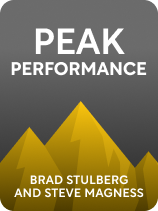
What factors contribute to personal development and growth? How do you recover your body after periods of strain?
According to Brad Stulberg and Steve Magness, achieving maximal performance requires understanding how to grow in the first place. Consequently, they begin by outlining their formula for the type of growth that allows you to harness your potential.
Continue reading to learn more about the top two personal development factors.
The Two Components of Growth
According to Stulberg and Magness, growth in any domain—mental, physical, or emotional—follows from a uniform formula. This formula holds that alternating between periods of stress and periods of rest yields consistent growth and they are the two biggest personal development factors. To show as much, they examine the training of elite athletes and elite creatives to illustrate that it conforms to this formula.
It’s helpful to clarify what Stulberg and Magness mean by stress and rest in the first place. They explain that:
- Stress is a type of stimulus that challenges the body or mind by pushing it near its limits. For example, to accustom their body to marathon pace, a marathon runner might run a series of one-mile intervals at race pace with only small breaks in between.
- Rest is a period of relative inactivity that gives the body or mind time to recuperate from the stressor. In the previous example, the marathon runner might take the next day off, or only go for an easy run, to allow their body time to recover.
(Shortform note: While rest in this context means what we’d typically expect it to, stress, in the sense of general feelings of worry and anxiety during demanding situations, is distinct from Stulberg and Magness’s usage of the term, which refers instead to a specific form of training. However, the two are connected, since training and exercise have been shown to reduce levels of stress by releasing endorphins that improve your mood.)
Stulberg and Magness point out that this cycle of stress and rest is ubiquitous among elite endurance athletes, according to research comparing the training patterns of elite athletes in various endurance sports, such as swimming, running, cycling, and cross-country skiing. This research found that, instead of continuously performing high-octane exercises every day, these athletes repeatedly alternated between periods of intense exercise and periods of recovery.
(Shortform note: Experts point out that the amount of rest necessary for optimal performance depends on the activity, with higher-impact activities like running and strength training demanding more rest than lower-impact activities like cycling and swimming. For example, whereas swimmers might only need one day of true rest per week, weightlifters may need several days of rest between each workout, if the workout is focused on a specific muscle group.)
But Stulberg and Magness also note that this pattern isn’t limited to athletes. On the contrary, they cite research from Hungarian psychologist Mihaly Csikszentmihalyi (Flow) showing that creative intellectuals embrace this same approach. Csikszentmihalyi interviewed the top intellectuals in various disciplines and found that they largely used the same strategy that athletes use when training: They were either focusing wholeheartedly on their research or taking time away from it to recuperate.
(Shortform note: German philosopher Immanuel Kant was a paragon of this approach, as he meticulously scheduled his daily life around intervals of work and rest. Every day, Kant woke up at five in the morning to smoke, meditate, and drink tea. Then he prepared his lectures and wrote from seven to one in the afternoon, after which he would eat and socialize with friends until four. Then, after his one-hour daily walk, he would spend the rest of the evening writing before going to sleep.)
The Importance of Rest for Intellectual Endeavors
Stulberg and Magness point out that though it’s unsurprising that rest is crucial for physical performance, the importance of rest is unexpected for intellectual endeavors. They explain that the mind needs rest because, like our muscles, its performance diminishes after stress. In defense of this claim, they point to several experiments that tested participants’ problem-solving skills after forcing half of them to participate in a mentally strenuous activity (like resisting the temptation of a nearby cookie or solving a tough puzzle). These experiments revealed that participants who had performed the strenuous activities consistently performed worse on problem-solving tasks than the other participants.
(Shortform note: As further evidence that the mind needs rest to optimize performance, researchers have found that sleep deprivation is associated with declining cognitive function. For example, sleep-deprived individuals have a significantly worse short-term memory than their well-rested peers, as well as a lower capacity for sustained attention and other attentional processes.)
In addition to helping our minds recuperate, Stulberg and Magness point out that rest fosters creative insights by activating the brain’s default mode network. The default mode network, they explain, was discovered by a psychiatrist who found that his patients’ brains remained extremely active (according to brain scans) even when they weren’t doing any concrete tasks. In other words, our subconscious mind is activated even when we aren’t consciously thinking, and Stulberg and Magness contend that this pattern generates creative insights out of the blue. For this reason, we disproportionately come up with new ideas while resting instead of actively working.
(Shortform note: While the default mode network is active whenever we rest, experts point out that certain rest activities can make our default mode network even more lively. For instance, daydreaming, ruminating on the past or future, and trying to empathetically understand other people strongly activate the default mode network. To increase creativity, try engaging in one or more of these activities while at rest.)
How to Use Stress to Grow
Having shown that a combination of stress and rest is essential for growth, Stulberg and Magness proceed to discuss the optimal way to structure these cycles. In this section, we’ll focus on three of their recommendations for incorporating stress in order to grow: Partake in challenges at the edge of your comfort zone, focus intensely during bouts of stress, and undergo short periods of stress.
How to Use Rest to Grow
In light of their proposed strategies for harnessing stress, Stulberg and Magness discuss the optimal strategies for the other half of their formula—rest. Although it’s tempting to think of rest as something passive, Stulberg and Magness argue that we should take active steps to rest effectively by practicing mindfulness, prioritizing sleep, and taking short walks.

———End of Preview———
Like what you just read? Read the rest of the world's best book summary and analysis of Brad Stulberg and Steve Magness's "Peak Performance" at Shortform.
Here's what you'll find in our full Peak Performance summary:
- That the quest for excellence leaves us suffering from exhaustion and burnout
- Why cycles of stress and rest are necessary for sustainable elite performance
- How to develop a consistent routine and structure your time






